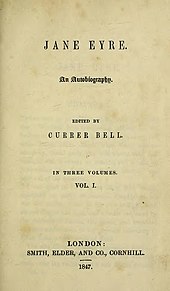Brussels
In 1842 Charlotte and Emily travelled to Brussels to enrol at the boarding school run by Constantin Héger (1809–96) and his wife Claire Zoé Parent Héger (1804–87). During her time in Brussels, Brontë who favoured the Protestant ideal of an individual in direct contact with God, objected to the stern Catholicism of Madame Héger, which she considered to be a tyrannical religion that enforced conformity and submission to the Pope. In return for board and tuition Charlotte taught English and Emily taught music. Their time at the school was cut short when their aunt Elizabeth Branwell, who had joined the family in Haworth to look after the children after their mother's death, died of internal obstruction in October 1842. Charlotte returned alone to Brussels in January 1843 to take up a teaching post at the school. Her second stay was not happy: she was homesick and deeply attached to Constantin Héger. She returned to Haworth in January 1844 and used the time spent in Brussels as the inspiration for some of the events in The Professor and Villette.
First publication
In May 1846 Charlotte, Emily and Anne self-financed the publication of a joint collection of poems under their assumed names Currer, Ellis and Acton Bell. The pseudonyms veiled the sisters' gender while preserving their initials; thus Charlotte was Currer Bell. "Bell" was the middle name of Haworth's curate, Arthur Bell Nicholls whom Charlotte later married, and "Currer" was the surname of Frances Mary Richardson Currer who had funded their school (and maybe their father). Of the decision to use noms de plume, Charlotte wrote:
Although only two copies of the collection of poems were sold, the sisters continued writing for publication and began their first novels, continuing to use their noms de plume when sending manuscripts to potential publishers.
The Professor and Jane Eyre
Brontë's first manuscript, The Professor, did not secure a publisher, although she was heartened by an encouraging response from Smith, Elder & Co. of Cornhill, who expressed an interest in any longer works Currer Bell might wish to send.[15] Brontë responded by finishing and sending a second manuscript in August 1847. Six weeks later, Jane Eyre was published. It tells the story of a plain governess, Jane, who, after difficulties in her early life, falls in love with her employer, Mr Rochester. They marry, but only after Rochester's insane first wife, of whom Jane initially has no knowledge, dies in a dramatic house fire. The book's style was innovative, combining naturalism with gothic melodrama, and broke new ground in being written from an intensely evoked first-person female perspective.[16] Brontë believed art was most convincing when based on personal experience; in Jane Eyre she transformed the experience into a novel with universal appeal.
Jane Eyre had immediate commercial success and initially received favourable reviews. G. H. Lewes wrote that it was "an utterance from the depths of a struggling, suffering, much-enduring spirit", and declared that it consisted of "suspiria de profundis!" (sighs from the depths). Speculation about the identity and gender of the mysterious Currer Bell heightened with the publication of Wuthering Heights by Ellis Bell (Emily) and Agnes Greyby Acton Bell (Anne). Accompanying the speculation was a change in the critical reaction to Brontë's work, as accusations were made that the writing was "coarse", a judgement more readily made once it was suspected that Currer Bell was a woman. However, sales of Jane Eyrecontinued to be strong and may even have increased as a result of the novel developing a reputation as an "improper" book. A talented amateur artist, Brontë personally did the drawings for the second edition of Jane Eyre and in the summer of 1834 two of her paintings were shown at an exhibition by the Royal Northern Society for the Encouragement of the Fine Arts in Leeds.
Shirley and bereavements
In 1848 Brontë began work on the manuscript of her second novel, Shirley. It was only partially completed when the Brontë family suffered the deaths of three of its members within eight months. In September 1848 Branwell died of chronic bronchitis and marasmus, exacerbated by heavy drinking, although Brontë believed that his death was due to tuberculosis. Branwell was also a suspected "opium eater"; a laudanum addict. Emily became seriously ill shortly after Branwell's funeral and died of pulmonary tuberculosis in December 1848. Anne died of the same disease in May 1849. Brontë was unable to write at this time.
After Anne's death Brontë resumed writing as a way of dealing with her grief, and Shirley, which deals with themes of industrial unrest and the role of women in society, was published in October 1849. Unlike Jane Eyre, which is written in the first person, Shirley is written in the third person and lacks the emotional immediacy of her first novel, and reviewers found it less shocking. Brontë, as her late sister's heir, suppressed the republication of Anne's second novel, The Tenant of Wildfell Hall, an action which had a deleterious effect on Anne's popularity as a novelist and has remained controversial among the sisters' biographers ever since.




No comments:
Post a Comment